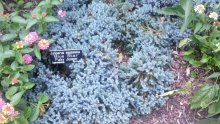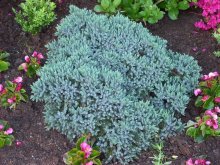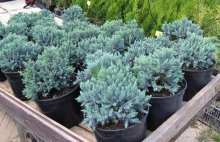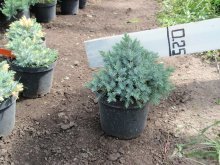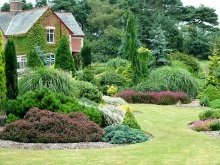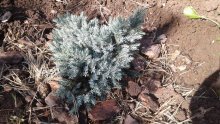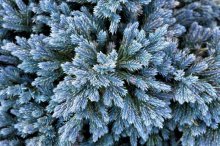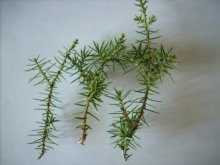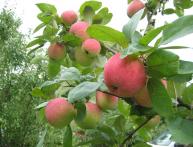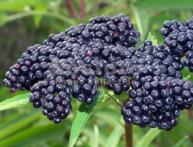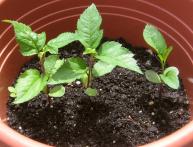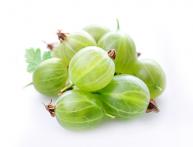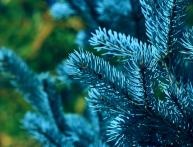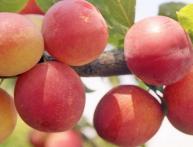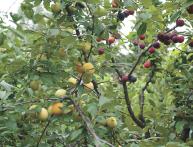Juniper Blue Star, planting and care, use in landscape design

One of the most common low-growing evergreen conifers in landscape design is Blue Star juniper, planting and caring for which does not require much effort.
It is distinguished not only by its sophistication and compactness, but also by its delicate pine aroma, which has an antiseptic effect. The blue color of the needles will decorate any garden, adding a unique charm to it.
Content:
- Description of the variety
- Planting Blue Star juniper and care rules
- Reproduction methods
- Pests and diseases of Blue Star juniper
- The use of Blue Star juniper in landscape design
Description of the variety
The name of the plant comes from the unusual bluish tint of the needles, which makes it look like a blue star. This evergreen shrub is also distinguished by the fact that it can change the shade of its needles depending on the time of year. Thus, the bluish tint of summer gives way to purple in winter.
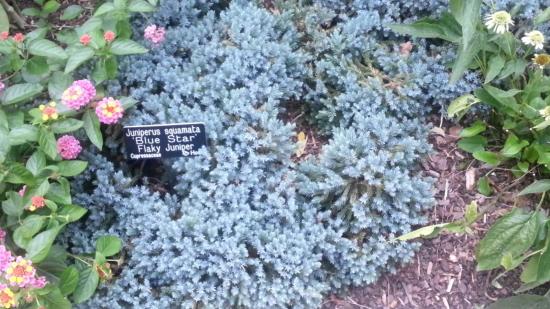
Other features of the plant include:
- The Blue Star juniper is small in size; it is a typical representative of dwarf species. In adulthood, it does not exceed 70 cm in height and one and a half meters in width;
- The needles are covered with small scales;
- Grows very slowly, no more than 8 cm per year;
- The crown takes on a dome-shaped shape and is highly dense;
- The needles that just appear have a turquoise tint, which over time gives way to grayish-blue.
Externally, the Blue Star differs from other representatives of its species only in its small size and magical color. However, even these differences were enough to receive well-deserved recognition among gardeners around the world.
You will learn even more about Blue Star juniper by watching the video:
Planting Blue Star juniper, care rules
It is important for every gardener who decides to plant bushes to remember some nuances of care.
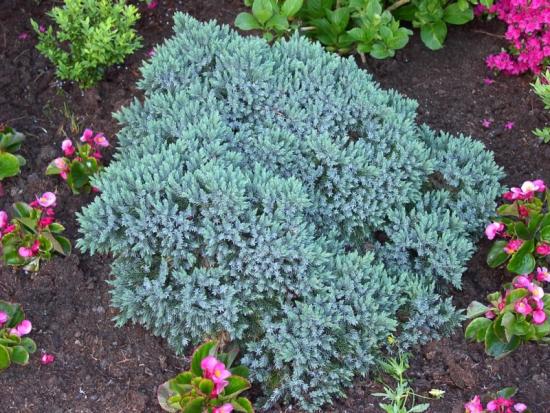
Planting juniper Blue Star and its care include a number of features:
- When planting, any soil is suitable, but Blue Star feels best on a fertile substrate rich in useful elements and microelements. The optimal mixture for this is peat, turf soil, fine sand in a ratio of 2:1:1 with a slightly acidic or neutral reaction;
- It is recommended to plant in well-lit areas. With a lack of light, the needles quickly fade, lose color, and the growth rate of the entire plant slows down;
- The size of the holes when planting should exceed the size of the root ball several times (often up to 70 cm). A drainage layer of gravel or small stones (thickness - 20 cm) must be installed at the bottom of the holes;
- The root collar of the juniper should not fall below the soil level;
- The shrub does not require watering; do not overwater it. The best option is moderate watering, which will not lead to rotting and death.
Only immediately after planting does the bush need abundant watering; a week after this, irrigation should be reduced.

After rooting the shrub, it is important not to forget to pay attention to it.
The main aspects of caring for it include:
- Fighting parasites and diseases - to prevent pathologies, you can use a one percent solution of Bordeaux mixture.When affected by disease or parasites, it is recommended to use insecticides and fungicides;
- Mulching and surface loosening - the latter is especially important for increasing the water and air permeability of the soil. In addition, it helps eliminate weed sprouts. It is better to do mulching in the spring, first sprinkling the soil with shavings and sand, and then covering it with mulch of decorative stones. An eight-centimeter layer will ensure optimal circulation of water and moisture;
- Pruning - timely removal of dead parts. The Blue Star does not need special pruning to form a bush, but removing damaged branches will not be superfluous;
- Top dressing - the first one is recommended to be done in mid-spring, add nitroammophoska. In the fall, in October, you can feed the soil with a potassium-phosphorus mixture;
- Watering - in the dry season, it is not superfluous not only to water, but also to spray the branches.
- It is recommended to cover young junipers with spruce branches for the winter; adults do not need such an event. If you follow simple rules for caring for this shrub, it will delight its owners with lush needles of an incredible bluish color.
Methods for propagating Blue Star juniper
This shrub is classified as a dioecious plant. Juniper propagation Blue Star can be produced in several ways.
The first is by sowing seeds. Despite the relative simplicity of implementing this option, they rarely resort to it; plants obtained in this way are not able to inherit the qualities of the mother bush and its decorative properties.
The second option is cuttings.
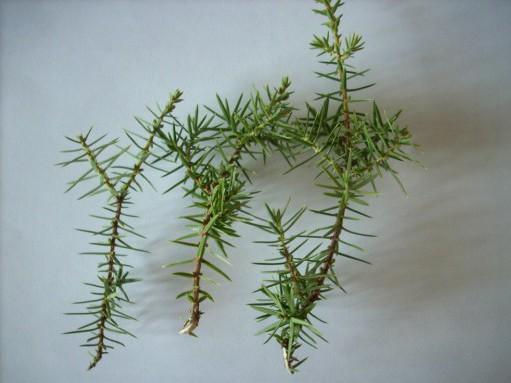
The procedure is as follows:
- Select bushes between seven and ten years old and prune them in mid-spring.Before cutting a branch, you need to thoroughly disinfect the pruning shears and cut off a branch 7-10 cm long with a patch from the trunk (part of the tree bark);
- It is recommended to clean the cutting at the base from needles, cut off the bark, and before planting, moisten it in a growth stimulator and keep it there for 24 hours;
- It is recommended to plant the prepared cuttings in a pot with a previously prepared substrate (a mixture of sand and peat). To activate rooting, the top of the seedling should be covered with a plastic bag or a cut-off bottle;
- Place the pot with the seedling in a dark place with a temperature of +20˚C.
- In a month and a half, the seedlings will sprout, which can be seen by the first young needles. After this, the bush is transplanted into a larger pot and only after a few years can it be planted in open ground.
You will learn more about the vegetative propagation of the plant by watching the video:
Pests and diseases of Blue Star juniper
Even high-quality care cannot completely protect the garden from the danger of pests.
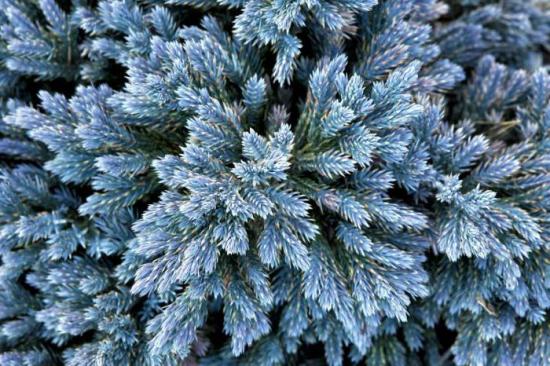
Therefore, it is important to remember what pests and diseases of Blue Star juniper can pose a danger to it:
- Rust is a disease characteristic of all junipers. It develops as a consequence of increased soil salinity, excessive watering or deteriorating environmental conditions. The disease can be identified by the characteristic reddish color that appears on needles and branches, followed by death. At the first signs of rust damage, it is recommended to remove the damaged parts and treat the bush with immunostimulants and microfertilizers (you can use Arcerid for spraying);
- Fungal diseases - characterized by slower growth and yellowing of needles, appear in early June - late May. To combat pathology, you need to treat the juniper with Arcerida, which is an insecticide. Spraying should be carried out once a week until the green pet has completely recovered. If Arceride or another insecticide of a similar effect is not at hand, you can use copper sulfate. When processing, it is important to pay attention to the location of the disease. If this is the initial stage and the fungal colonies have managed to capture only some branches, you can simply remove the damaged branches and treat the neighboring ones;
- Harmful insects (needle mite, scale insects, aphids, leafminer moths). It is not possible to cope with harmful insects using folk remedies alone; you must arm yourself with special preparations. To combat aphids, Fitoverm is suitable, with shitovka - karbofos, with moths - Decis, with mites - Karate. In addition, in the fight against parasites, you can use products such as BI-58 or Topaz.
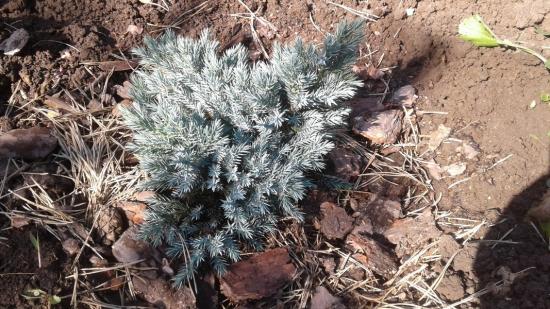
Diseases and pests are a common problem for outdoor plants that do not depend on their care.
However, if the treatment is carried out after the first signs of pathology, the likelihood of a successful outcome with minimal damage to the bush increases significantly.
The use of Blue Star juniper in landscape design
Blue star is deservedly popular among many gardeners. It is used both for planting on mixborders and on alpine hills and flower beds consisting of several levels.
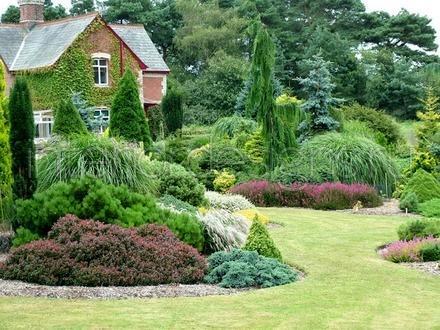
The extraordinary bluish color attracts with its amazingly beautiful contrast with the green foliage of the summer garden.The miniature shrub looks no less attractive in the winter season, retaining its foliage even under snow cover.
Blue Star can also become a decoration for flowerbeds that are common in landscape design, such as multi-level evergreens. When evergreen trees of different heights are gathered on one site to delight the owners not only with summer, but also with a riot of colors in winter.
Other advantages of the culture include its antibacterial effect. Shrubs planted in the garden will provide a flow of fresh air, not only pleasing the eye, but also contributing to the overall health of the body.
You can buy Blue Star scaly juniper at a nursery that specializes in growing this crop, order it online, or purchase it in a specialized store. However, it is important to remember that the second option should be approached with extreme caution, as there is a risk of running into scammers.
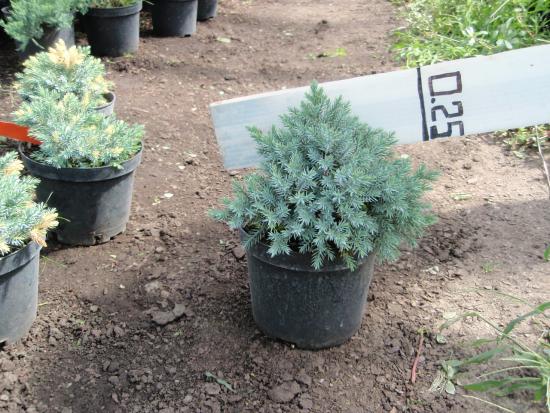
If you follow the simple rules of caring for the shrub, it will delight its owners with its unearthly beauty, which can be enjoyed at all times of the year.
Growing Blue Star juniper does not involve many problems, as it is an unpretentious plant. However, care must be timely, which is important to consider when planting and regulating watering.

